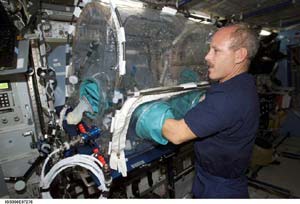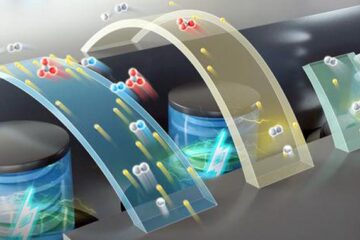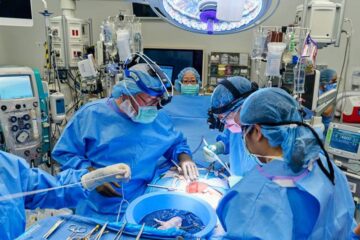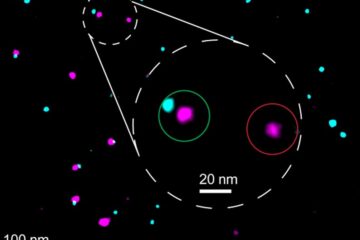Space Station crew, scientists fine-tune zeolite experiment

Expedition Six Commander Ken Bowersox uses a portable plastic enclosure called the Maintenance Work Area on Dec. 16, 2002, to prepare Zeolite Crystal Growth sample tubes for processing. Hard as a rock, yet able to absorb liquids and gases like a sponge, zeolites form the backbone of the chemical processes industry on Earth. By using the International Space Station’s microgravity environment to grow larger, better quality crystals, NASA and its commercial partners hope to improve petroleum manufacturing and other processes. (Credit: NASA/JSC) <br> <br>
The Zeolite Crystal Growth (ZCG) experiment got off to a successful start this week aboard the International Space Station.
Hard as a rock, yet able to absorb liquids and gases like a sponge, zeolites form the backbone of the chemical processes industry. Virtually all the world’s gasoline is produced or upgraded using zeolites. Improving zeolites could make gasoline production more efficient or lead to ways of storing clean-burning hydrogen for fuel. Zeolites can also be applied to detergents, optical cables, gas and vapor detectors for environmental monitoring.
The microgravity environment of the Space Station allows scientists to grow higher-quality crystals that are 100 to 500 times larger than normal for analysis and test the crystallization process in “slow motion” without being rushed by the effects of gravity.
On Monday, Expedition Six Commander Ken Bowersox used a Space Station drill to mix 12 zeolite samples in clear tubes to evaluate how much to mix the actual test samples the next day. Scientists on the ground watching on TV noticed bubbles in the samples, which could cause smaller crystals and worked together with Bowersox to develop some changes in the mixing process.
On Tuesday, Bowersox used the modified mixing procedure to process 15 of the 19 autoclaves to isolate the bubbles believed to be in the samples. He then re-inserted the samples in the ZCG furnace in EXPRESS Rack 2 in the Station’s Destiny Laboratory. The experiment then began a heat-up and cool-down cycle that will last just over 15 days.
“The exciting thing is we are using the crew to make intelligent decisions,” said Dr. Al Sacco, Jr., principal investigator for the experiment. “It has already helped in the sense we’ve seen more bubbles in these solutions than we anticipated. These bubbles could cause larger numbers of smaller, deformed crystals to grow.”
“In real time, we changed some of our procedures, said Sacco, director of the Center for Advanced Microgravity Materials Processing (CAMMP) at Northeastern University, Boston, Mass. “Ken tried a couple of things. We gave him some additional ideas. As a result, he rotated the samples in such a way that it should throw the heavier fluid to the outside and the lighter bubbles to the inside. It’s going to make a huge difference in the results. We expect to get larger crystals and fewer malformed crystals. It was great interchange between scientists on the ground and the crew in space.”
The ZCG experiment was aided by the new Active Rack Isolation System (ARIS) that damps out vibrations created by crew movement, operating equipment and other activities on the Station. The Station science team reported that ARIS is successfully lowering the vibration levels in EXPRESS Rack 2.
Also Monday, Expedition Six Science Officer Don Pettit removed a rear panel on the ARCTIC 1 freezer, which malfunctioned during Expedition Five. ARCTIC is designed to store biological samples after processing. Pettit did a series of electrical tests, which were unable to restore the freezer to full operations. The operations team is now evaluating plans to return the freezer to Earth for repairs. The problem does not affect science operations, and no samples were stored in the freezer.
On Tuesday, the crew installed pivot pin fittings and a heater jumper cable in the Destiny lab rack location where the Window Observational Research Facility (WORF) will be installed on the ULF-1 mission. ULF-1, which is the start of Expedition Seven, will mark the beginning of WORF’s planned Earth observations research.
On Wednesday, Bowersox performed some calibration tests on the new Foot/Ground Reaction Forces During Space Flight (FOOT) experiment prior to the start of science operations. FOOT is designed to characterize the stress on the lower extremity bones and muscles in microgravity.
Among the Crew Earth Observation (CEO) photography subjects for this week were Lake Victoria in East Africa, which supplies fish for the surrounding population, the beginning of fire season in West Africa, coral formations around Tuamotu-Austral Islands, Baker Island and Howland Island in the Central Pacific, and the urban area of Chicago, Ill.
The crew during the week also continued to perform daily status and maintenance checks on Station science payloads and equipment.
The Payload Operations Center at NASA’s Marshall Space Flight Center in Huntsville, Ala., manages all science research experiment operations aboard the International
Space Station. The center is also home for coordination of the mission-planning work of a variety of international sources, all science payload deliveries and retrieval, and payload training and payload safety programs for the Station crew and all ground personnel.
Media Contact
More Information:
http://www1.msfc.nasa.gov/NEWSROOM/news/photos/2002/photos02-320.htmlAll latest news from the category: Power and Electrical Engineering
This topic covers issues related to energy generation, conversion, transportation and consumption and how the industry is addressing the challenge of energy efficiency in general.
innovations-report provides in-depth and informative reports and articles on subjects ranging from wind energy, fuel cell technology, solar energy, geothermal energy, petroleum, gas, nuclear engineering, alternative energy and energy efficiency to fusion, hydrogen and superconductor technologies.
Newest articles

High-energy-density aqueous battery based on halogen multi-electron transfer
Traditional non-aqueous lithium-ion batteries have a high energy density, but their safety is compromised due to the flammable organic electrolytes they utilize. Aqueous batteries use water as the solvent for…

First-ever combined heart pump and pig kidney transplant
…gives new hope to patient with terminal illness. Surgeons at NYU Langone Health performed the first-ever combined mechanical heart pump and gene-edited pig kidney transplant surgery in a 54-year-old woman…

Biophysics: Testing how well biomarkers work
LMU researchers have developed a method to determine how reliably target proteins can be labeled using super-resolution fluorescence microscopy. Modern microscopy techniques make it possible to examine the inner workings…





















